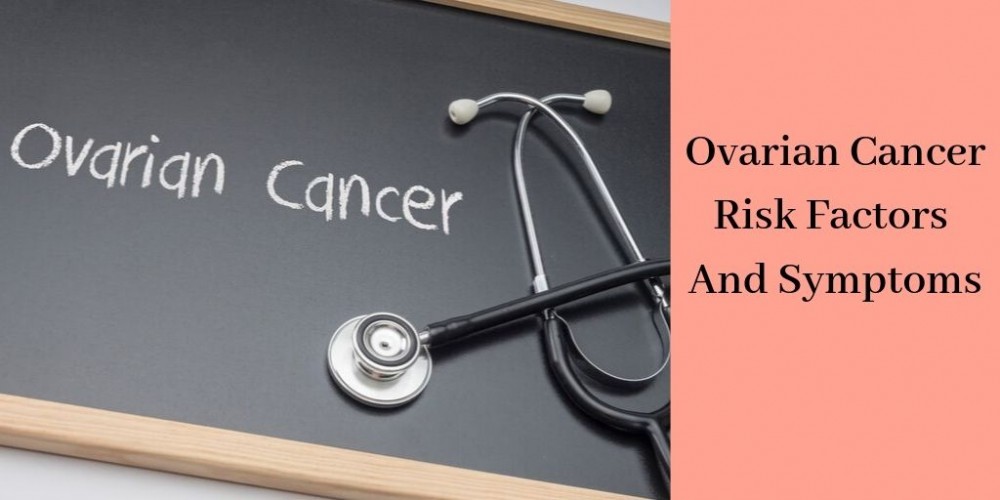Ovarian cancer is referred to as the “silent killer” and for good reason. The symptoms associated with the disease can be somewhat vague in nature, that by the time the cancer is diagnosed, it has progressed to the point that treatment is ineffective. Keep reading to learn more about ovarian cancer risk factors and the symptoms that could potentially be early warning signs.

Here’s a sobering statistic; only a small percentage, roughly 15-20%, of ovarian cancers are found in the early stages when treatment response would be favorable. Sadly, early-stage cancers rarely manifest with any symptoms. When symptoms do present, they’re often mistaken for conditions that are benign. The cancer, by that point, has often already spread to regions within the abdomen and pelvis.
Symptoms are important as they provide possible clues to what’s going on internally. Being aware of the warning signs, and getting diagnosed before the cancer has spread, is key to survival. Unfortunately, symptoms many times are not taken seriously, until the cancer has become aggressive.

 What Is Ovarian Cancer?
What Is Ovarian Cancer?
Cancer occurs from cellular mutations in DNA. These mutations send signals to the cell to rapidly grow and multiply. Tumors form as a result of this abnormal growth, causing cells to proliferate and invade surrounding tissues.
Ovarian cancer is the result of DNA mutations within the ovaries, which are part of the female reproductive system. Each ovary is approximately the size of an almond. Their function is to produce eggs, along with progesterone and estrogen, both female hormones.
The death of Canadian plus-size model Ashley Luther, better known as Elly MayDay, has garnered attention for ovarian cancer. Elly MayDay was a body-positivity advocate who openly shared her cancer journey. Tragically, she died March 1, 2019. She was only 30 years old.
Luther was diagnosed with stage three ovarian cancer in 2013, three years after she started experiencing symptoms, such as bloating and lower back pain. Sadly, her symptoms were dismissed by her health care providers until it was too late. If you experience any of the symptoms listed below, to any degree, get them checked out immediately. It could be a matter of life and death.
Types Of Ovarian Cancer
The type of ovarian cancer is determined by the type of cell from where it originates. There are three types including:
1. Epithelial tumors: This is the most common type of ovarian cancer, with up to 90% of cancers beginning in the epithelial tissue surrounding the ovaries.
2. Stromal tumors: Tumors originate in the cells that produce hormones, and are typically diagnosed earlier than other types of ovarian tumors. Stromal tumors account for only 7% of ovarian cancers.
3. Germ cell tumors: A form of ovarian cancer that tends to occur in teenagers and young women. It develops in the germ cells that produce eggs.

 Ovarian Cancer Risk Factors
Ovarian Cancer Risk Factors
Although, it’s unknown what causes ovarian cancer, there are certain risk factors that increase the odds that a person will develop the disease. However, many women with ovarian cancer are considered low risk. Conversely, having several risk factors does not mean you will get ovarian cancer. Most cases of ovarian cancer occur in women over 50. Risk factors include:
- Age, the older you are, the higher your risk
- Having the BRCA1 or BRCA2 genetic mutation
- Taking estrogen without progesterone for prolonged periods
- Being diagnosed with endometriosis
- Having an Ashkenazi Jewish or Eastern European background
- Difficulty conceiving or never experiencing a pregnancy or birth
- Having two close family members who have had the disease
- Early menstruation before the age of 12
- Menopause after the age of 52
- Having had an IUD
[Read More: 5 Ways A Cancer Coach Can Support Someone With Cancer]
Symptoms Of Ovarian Cancer
The symptoms of ovarian cancer are non-specific and can easily correlate to other conditions. This is why the disease is so deadly. By the time the symptoms are taken seriously, and the disease diagnosed, the cancer is already advanced and aggressive.
Ovarian cancer is a relentless disease. Half of all patients who receive treatment with chemotherapy, and have gone into remission, will have a recurrence of the disease within three years.
- Back and abdominal pain
- Painful urination and frequency
- Constipation and diarrhea
- Bloating and a feeling of fullness
- Indigestion and heartburn
- Fatigue
- Loss of appetite
- Worsening muscle weakness
- Skin rashes
- Vaginal bleeding
- Painful or missed periods
- Trouble breathing
- Unexplained weight loss
Why Symptoms Occur
It’s not unusual to occasionally experience any of the symptoms above, it’s when they become chronic and are not alleviated by normal interventions, such as changes in diet, rest, and stress reduction, that alarms bells should go off. As ovarian tumors grow, they press on the bowel, bladder, uterus, stomach, and lungs, which create the symptoms, including alternating diarrhea and constipation, incontinence, heartburn, cramping, and difficulty breathing.
Cancer impacts metabolism, which can cause changes in appetite. Abominable pain is another symptom of ovarian cancer, any pain that lasts longer than a couple of weeks that isn’t due to menstruation or a virus, should be cause for concern. This holds true for back pain that can feel similar to labor pains.
Chronic bloating can be a symptom of ovarian cancer, with bloating being significant enough that a woman’s clothes may be tight, without making changes in eating or exercise habits. Alternatively, unexplained weight loss that happens quickly could signal that something isn’t right. Abnormal fatigue is another potential warning sign, particularly in the broader context of other symptoms.
Access Direct-To-Consumer Lab Testing For Ovarian Cancer Here
Holistic Strategies
Alternative therapies can be used in conjunction with conventional cancer treatments, or alone if the disease is diagnosed in the early stages and hasn’t yet spread. These techniques fortify the immune system, making it more resilient and better able to fight the disease. Below are some of my favorite alternative therapies for strengthening the body while fighting cancer;
1. Rife therapy: Rife generators destroy harmful organisms using electrical force, and are used in conjunction with other healing modalities. Rife frequencies improve immune function, reduce inflammation, accelerate healing, and increase energy. The best way to use these frequencies consistently is to buy your own generator to use at home.
[Read More: How Is Rife Therapy Used To Treat Cancer?]
2. Ozone therapy: Ozone exerts its therapeutic effects via oxidative stress. It stimulates the production of white blood cells, kills pathogenic organisms, raises blood oxygen levels, and inhibits cancer cell division. You can purchase your own ozone generator, or ozone sauna, to use at your discretion in the comfort of your own home.
[Read More: The Health Benefits Of Ozone Therapy]
3. High-dose enzyme therapy: Enzymes breakdown tumors, and the outer coating of viruses. This enables the immune system to more effectively eradicate them. Enzymes boost the efficacy of conventional cancer therapies, reduce inflammation, break down fibrin, improve liver function, and decrease pain.
[Read More: High Dose Enzyme Therapy For Cancer]
4. PectaS0l-C: PectolSol-C is a modified citrus pectin, which inhibits numerous mechanisms that allow cancer to develop. One of these mechanisms is by blocking galectin-3, an adhesion molecule, that enables malignant cells to clump together.
[Read More: The Benefits Of PectaSol-C For Cancer]
Key Points
Although, ovarian cancer is quite rare, it’s the most common type of cancer in women, and the eighth most common type of cancer in the United States.
It’s the fifth leading cause of death, but the good news is that rates are declining. Ovarian cancer is diagnosed most frequently in Caucasian women.
Do you know someone that has had ovarian cancer? Let me know in the comments:)





Thank you for this information on ovarian cancer and its symptoms and warning signs. Being a woman myself with two female children, I have always been highly interested in the health of female reproductive system.
There are quite a few cases of breast cancer on my mother’s side of the family. Is there any correlation in the risk factors of breast cancer and ovarian cancer? I always wondered if it was simply breast cancer we should be on the look out for or if cancer in any female organ is heightened in these cases. Thanks so much for your input!
Hi Shan,
Thanks for reading my post on ovarian cancer. It’s important for women of all ages to be aware of the symptoms of ovarian cancer so it can be diagnosed in the early stages and treated when the prognosis is still good.
There is a correlation in risk factors with breast and ovarian cancer due to the BRCA1 and BRCA2 mutations. Genetics, however, only plays a part in the development of disease. Live a healthy lifestyle to reduce your chances in both cases. Just because a woman has the genes doesn’t mean they will be expressed. This is where Epigenetics comes in and why healthy living is so essential.
Hello,
Great information! As a male, I didn’t know about a lot of the information presented in your article. I didn’t even realize there was more than one type of ovarian cancer which affects women. I have heard of it being a silent killer, and after reading this article I completely understand why.
Are there any recommendations for women which can help them keep an eye out for the symptoms and seek help if they feel think something is wrong? Also, are there any preventative measures women and young girls can take to help reduce their chances of ovarian cancers?
Best regards,
Jefrey M.
Hi Jefrey,
Thank you. Many people don’t know the risk factors or symptoms of ovarian cancer, and that it’s often referred to as the silent killer. All of us can reduce our cancer risk by living a healthy lifestyle in terms of getting adequate nutrition, exercising consistently, maintaining a healthy weight, reducing stress, and detoxifying.
Ovarian cancer is deadly because the symptoms are many times not taken seriously. Women who experience worrisome symptoms that correlate with ovarian cancer need to push for answers, even if they need to find another doctor who will listen and act upon their concerns.
If diagnosed in the early stages, ovarian cancer can be treated successfully. Thanks so much for reading!